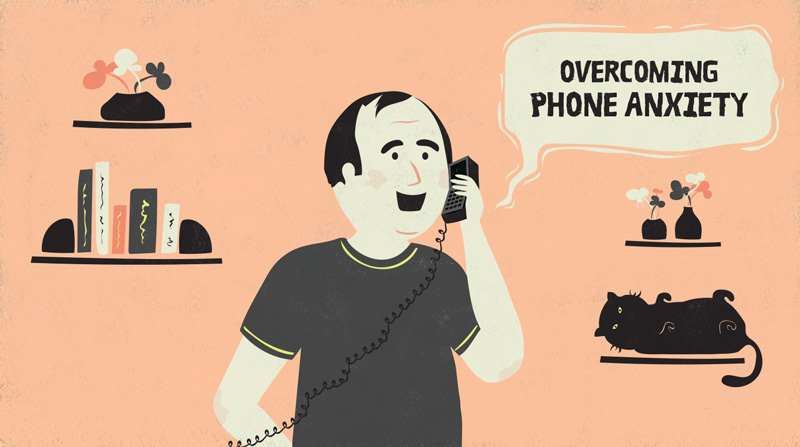Breaking the Silence: A Comprehensive Guide to Overcoming Phone Anxiety

Introduction
In an era dominated by digital communication, the phone remains a powerful tool for connecting with others personally and professionally. However, for many individuals, the prospect of making or receiving phone calls can evoke a range of anxieties. Whether stemming from fear of judgment, social discomfort, or a preference for written communication, phone anxiety can be a significant challenge to overcome. This comprehensive guide explores the roots of phone anxiety, its impact on personal and professional life, and offers practical strategies to empower individuals in breaking the silence and mastering effective phone communication.
Understanding Phone Anxiety
1. Identifying the Roots of Anxiety:
- Phone anxiety often stems from a combination of social, psychological, and communication factors. Understanding the root causes, such as fear of judgment, uncertainty in conversation, or a lack of control, is the first step towards overcoming phone anxiety.
2. Impact on Personal and Professional Life:
- Phone anxiety can have far-reaching consequences, affecting personal relationships, hindering professional growth, and limiting opportunities for effective communication. Recognizing the broader impact of phone anxiety underscores the importance of addressing it proactively.
3. Common Triggers:
- Common triggers for phone anxiety may include fear of rejection, concern about not being articulate, or a general discomfort with spontaneous conversation. Identifying specific triggers allows individuals to tailor strategies for overcoming anxiety in targeted ways.
Strategies for Overcoming Phone Anxiety
1. Gradual Exposure:
- Overcoming phone anxiety often involves gradual exposure. Start by making short, low-pressure calls to friends or family before progressing to more formal or professional calls. Gradual exposure helps desensitize individuals to the anxiety-inducing aspects of phone communication.
2. Preparation and Scripting:
- Prepare for phone calls by outlining key points or scripting essential information. Having a script or an outline can provide a sense of security and confidence, particularly in situations where one might feel unsure about what to say.
3. Visualization Techniques:
- Visualization techniques, such as imagining a successful phone call or envisioning a positive outcome, can be powerful tools for managing anxiety. Visualization helps shift the focus from potential negative scenarios to more optimistic and empowering mental images.
4. Breathing Exercises:
- Incorporate breathing exercises to manage anxiety symptoms. Deep and intentional breathing can help regulate the nervous system, reduce physical tension, and promote a sense of calmness before and during phone conversations.
5. Positive Affirmations:
- Develop a set of positive affirmations to counter negative thoughts associated with phone anxiety. Repeating affirmations such as “I am capable of effective communication” or “I can handle phone conversations with ease” can reshape one’s mindset.
6. Building Phone Skills:
- Actively work on building phone communication skills through practice. Engage in role-playing exercises with a friend or mentor, focusing on common scenarios that trigger anxiety. Regular practice enhances confidence and proficiency over time.
Practical Approaches for Phone Conversations
1. Establishing a Comfortable Environment:
- Set the stage for successful phone conversations by creating a comfortable environment. Choose a quiet and private space to minimize distractions and interruptions, allowing individuals to focus on the conversation without added stressors.
2. Setting Clear Objectives:
- Define clear objectives for each phone call to provide a sense of purpose and direction. Whether it’s conveying information, seeking clarification, or building a connection, having specific goals helps individuals stay focused and confident during the conversation.
3. Active Listening Techniques:
- Develop active listening skills to enhance engagement during phone conversations. Practice techniques such as paraphrasing, summarizing, and asking clarifying questions to demonstrate attentiveness and ensure a mutual understanding.
4. Asking Open-Ended Questions:
- Foster meaningful conversations by asking open-ended questions. Open-ended questions encourage dialogue, allowing for more natural and flowing conversations. This approach can alleviate the pressure of feeling solely responsible for steering the discussion.
5. Recognizing Silence:
- Embrace silence as a natural part of communication. Individuals experiencing phone anxiety may fear moments of silence, interpreting them as awkward. Recognizing the value of pauses and allowing space for thoughtful responses contributes to a more relaxed conversational atmosphere.
Professional Development and Networking
1. Networking and Professional Growth:
- Overcoming phone anxiety is particularly crucial in professional settings where phone communication is integral to networking and career advancement. Actively seek opportunities to engage in phone conversations for networking, mentorship, and professional development.
2. Seeking Support and Mentorship:
- Reach out to mentors or colleagues who can provide guidance and support. Sharing experiences with others who have navigated phone anxiety can offer valuable insights and encouragement, fostering a sense of community in overcoming shared challenges.
3. Participating in Communication Workshops:
- Consider participating in communication workshops or courses that specifically address phone anxiety. These programs often provide practical tips, interactive exercises, and supportive environments for individuals to build their phone communication skills.
Long-Term Strategies for Managing Phone Anxiety
1. Cognitive Behavioral Therapy (CBT):
- For persistent phone anxiety, consider seeking the support of a mental health professional, particularly one specializing in cognitive-behavioral therapy (CBT). CBT can be effective in identifying and addressing negative thought patterns associated with phone anxiety.
2. Mindfulness and Meditation Practices:
- Integrate mindfulness and meditation practices into daily routines. Mindfulness can help individuals stay present during phone conversations, manage anxious thoughts, and cultivate a more centered and composed mindset.
3. Regular Self-Reflection:
- Engage in regular self-reflection to monitor progress and identify areas for improvement. Celebrate successes, no matter how small, and adjust strategies based on ongoing self-awareness. Self-reflection contributes to continuous growth and resilience.
Conclusion
Overcoming phone anxiety is a journey that requires patience, self-compassion, and a commitment to personal growth. By understanding the roots of anxiety, implementing practical strategies, and actively engaging in phone communication, individuals can break the silence and transform phone conversations from sources of fear into opportunities for connection and empowerment. This comprehensive guide equips individuals with the tools they need to navigate phone anxiety, fostering a more confident and effective approach to communication in both personal and professional spheres.







